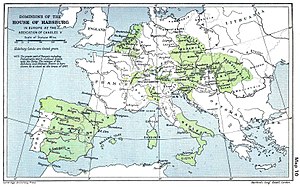Europa regina

Europa regina,
Origins
During the European
The Putsch-map was the first to depict Europe as an Europa regina,
In 1587,
Symbolism
Europa Regina was introduced in the 1530s by the Austrian cartographer Johannes Putsch, possibly with the intent of depicting Europe as the spouse of Charles V of Habsburg, who aspired to become the universal monarch of Christendom and reigned over numerous realms including the Holy Roman Empire and the kingdom of Spain.[3][7] Arguments in favour of this hypothesis are: the westward orientation of the map to have Hispania as the crowned head, said to resemble the face of Charles V's wife, Isabella of Portugal; the use of the Holy Roman Empire's insignia - its Carolingian crown, sceptre and orb - and the portrayal of Habsburg realms (Austria, Bohemia, Hungary, Germany) as the heart and centre of the body; and the design of the gown, which resembles the contemporary dress code at the Habsburg court.[9][7][3][10] As in contemporary portraits of couples, Europa regina has her head turned to her right and also holds the orb with her right hand, which has been interpreted as facing and offering power to her imaginary husband, the emperor.[10]
Outside this and in more general terms, Europe is shown as the res publica christiana,[7] the united Christendom in medieval tradition,[3] and great[1] or even as the dominant power in the world.[10]
A third allegory is one of Europe as Paradise through the special placement given to the bodies of water on the map.[7] As contemporary iconography depicted paradise in enclosed form, Europa regina is enclosed by seas and rivers.[7] The Danube river is depicted in a way that it resembles the course of the biblical river flowing through paradise, with its estuary formed by four arms.[7]
That Europa regina is surrounded by water is also an allusion to the
Europa regina belongs to the Early Modern allegory of Europa triumphans, as opposed to Europa deplorans.[11]
Related maps
The art of shaping a map in a human form can also be found in a map drawn by Opicinus de Canistris, showing the Mediterranean Sea.[4] This map, published in 1340 and thus predating the Putsch map, showed Europe as a man and Northern Africa as a woman.[5] The Leo Belgicus map showed the Low Countries as a lion; this was closer to the modern map orientation, with north at the top.
While in Europa regina maps, actual geography is subordinate to the female shape, the opposite approach is seen in a map drawn by Hendrik Kloekhoff and published by Francois Bohn in 1709. In this map, titled "Europa. Volgens de nieuwste Verdeeling" ("Europe, according to the newest classification"), a female is superimposed on a map showing a fairly accurate geography of Europe, and although the map is oriented westward with the Iberian Peninsula forming the head as in the Europa regina imagery, this results in a crouching female shape, corresponding more with the Europa deplorans than the Europa triumphans allegory.[12]
See also
- Europa (consort of Zeus)
- Woman of the Apocalypse
- History of Spain
- National personification
- Personification of the Americas
Sources
References
- ^ a b Landwehr & Stockhorst (2004), p. 279
- ^ Werner (2009), p. 243
- ^ a b c d e f Werner (2009), p. 244
- ^ a b c d e f g Borgolte (2001), p. 16
- ^ a b Bennholdt-Thomsen (1999), p. 22
- ^ a b c d e f g h i Schmale (2004), p. 244
- ^ a b c d e f g h i j k Wendehorst & Westphal (2006), p. 63
- ISSN 1377-2368. Retrieved 2024-03-21.
- ^ Europeanness in Early Modern Latin Literature, Isabella Walser-Bürgler, p.60
- ^ a b c d Werner (2009), p. 245
- ^ Werner (2009), pp. 243ff
- ^ Bennholdt-Thomsen (1999), pp. 22-24
Bibliography
- Baridon, Laurent (2011). Un atlas imaginaire, cartes allégoriques et satiriques (in French). Paris: Citadelles & Mazenod. ISBN 978-2-85088-515-0.
- Bennholdt-Thomsen, Anke (1999). Bennholdt-Thomsen, Anke; Guzzoni, Alfredo (eds.). Zur Hermetik des Spätwerks. Analecta Hölderlianas (in German). Vol. 1. Würzburg: Königshausen & Neumann. ISBN 3-8260-1629-7.
- Borgolte, Michael (2001). "Perspektiven europäischer Mittelalterhistorie an der Schwelle zum 21. Jahrhundert". In Lusiardi, Ralf; Borgolte (eds.). Das europäische Mittelalter im Spannungsbogen des Vergleichs. Europa im Mittelalter. Abhandlungen und Beiträge zur historischen Komparatistik (in German). Vol. 1. Berlin: Akademie Verlag. pp. 13–28. ISBN 3-05-003663-X.
- Werner, Elke Anna (2009). "Triumphierende Europa - Klagende Europa. Zur visuellen Konstruktion europäischer Selbstbilder in der Frühen Neuzeit". In Ißler, Roland Alexander; Renger, Almut-Barbara (eds.). Europa- Stier und Sternenkranz. Von der Union mit Zeus zum Staatenverbund. Gründungsmythen Europas in Literatur, Musik und Kunst (in German). Vol. 1. Bonn University Press, Vandenhoeck & Ruprecht. pp. 241–260. ISBN 978-3-89971-566-8.
- Landwehr, Achim; Stockhorst, Stefanie (2004). Einführung in die europäische Kulturgeschichte. UTB M (in German). Vol. 2562. Paderborn: Schöningh. ISBN 3-8252-2562-3.
- Schmale, Wolfgang (2004). "Europa, Braut der Fürsten. Politische Relevanz des Europamythos im 17. Jahrhundert". In Bussmann, Klaus; Werner, Elke Anna (eds.). Europa im 17. Jahrhundert. Ein politischer Mythos und seine Bilder. Kunstgeschichte (in German). Stuttgart: Franz Steiner Verlag. ISBN 3-515-08274-3.
- Wendehorst, Stephan; Westphal, Siegrid (2006). Lesebuch altes Reich. Bibliothek Altes Reich (in German). Vol. 1. Munich: Oldenbourg Wissenschaftsverlag. ISBN 3-486-57909-6.
External links
 Media related to Europa regina at Wikimedia Commons
Media related to Europa regina at Wikimedia Commons- Opicino de Canistris' map showing Europe as a man and Africa as a woman, hosted at mittelalter-server.de


